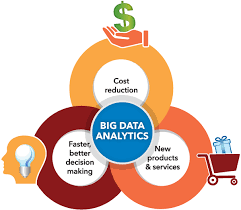Data is a collection of information in the form of images, text, videos, symbols, facts, and numbers, that can be stored, recorded, or analyzed. In the modern world where everything is connected to the Internet, the collection of data is at its peak. New data is being created, data is being collected, organized, and analyzed at a scale that you cannot imagine.
Data is the foundation for information, knowledge, and eventually insights.
Big Data on the other hand refers to extremely large and complex datasets, for which you need to deploy special techniques to manage and analyze them.
The Term: Big Data
The Big Data term came to be used in the 1990s and John Mashey is credited for popularizing this term. Big Data generally includes an enormous set of data that cannot be managed by common software tools. It requires certain techniques integrated with the technologies that analyze the diverse, complex, and massive amount of data.
Introduction to Big Data
With the continuous evolution of technology, there has been an abrupt increase in the amount of data with time. The data has so much grown in volume that the traditional data management methods and tools were not able to store or process the data efficiently. This huge volume of complex data is called Big Data.
Some examples of Big Data are:
-
About 1 TB of new trade data in a single day is generated alone by The New York Stock Exchange.
-
People add more than 500 TB of new data on various social media applications such as Facebook, and Instagram every single day in the form of videos, photos, messages, and comments.
-
More than 10 TB of data is generated during a 30-minute flight of a single Jet engine and there are several Jet engine flights every single day.

Types of Big Data
Big Data can be categorized into 3 types:
- Structured: The data stored in a fixed format is known as structured data, for example, the data stored in relational database management systems(DBMS) or Tables.

- Unstructured – The data that is not stored in a fixed format is called unstructured data, for example, a combination of text files, images, videos, and numbers stored within the database of the organization, such as Google Search in its raw form or unstructured format.

- Semi-structured – The data stored in the files, such as XML files, seems to be structured but in actuality, it is present in an unstructured format. For example, personal data is stored in an XML file.

Characteristics of Big Data
The following characteristics can be used to describe Big Data:
-
Volume - Volume is one of the most fundamental characteristics that are required to be considered while learning about Big Data. The size of the stored and transmitted data determines the value of the data. Big Data, as the name suggests is data with enormous size in terms of volume.
-
Variety - The data can come from various sources and in various forms (structured, unstructured, semi-structured). With the advent of new technology, the is present everywhere today in the form of emails, photos, videos, PDFs, audio, and many more in unstructured or raw form which creates issues regarding its storage and analysis. Therefore, variety is the second most important characteristic that defines Big Data.
-
Velocity - The data is generated nowadays at a massive and continuous speed to meet the demands of the people. Big Data Velocity refers to the speed at which the data flows from various sources such as networks, applications, mobile devices, and business processes.
-
Variability - The data is produced very inconsistently and thus the efforts to handle and manage the enormous amount of data are in vain.

Advantages of Big Data Processing
Effectively processing Big Data has great advantages. Some of them are:
-
Improved Business Strategies - More effective business strategies can be developed by using outside intelligence by accessing social data from search engines and websites.
-
Improved Services for Customers - The customer responses can be analyzed and evaluated using customer feedback solutions that leverage natural language processing technologies to gain deeper insights and identify areas for improvement. Therefore, Big Data technologies are replacing the traditional systems of customer feedback systems at a faster pace.
-
Efficiency in Better Operation - Big Data Technologies offer a staging area or landing zone to be created for the new data before it is decided what data should be added to the data warehouse. The infrequently accessed data can be offloaded by the integration of the technologies of Big Data and Data warehouses.

Applications of Big Data
Following are some of the major applications of Big Data:
-
Increased job opportunities - The demand for information management specialists in many esteemed companies, including Oracle Corporation, IBM, Microsoft, SAP, EMC, and HP is increasing rapidly.
-
Effective exchange of information - The exchange of information through telecommunication was about 667 exabytes annually in 2014. About one-third of stored information is only in the form of alphanumeric text and images offering the most useful format for Big Data technologies.

Conclusion
Big data is the enormous amount of data generated daily on various social media websites, mobile devices, applications, and sensors that can be present in structured, unstructured, and semi-structured forms. The study of characteristics of Big Data offers many advantages to organizations, such as improved business strategies, improved services for customers, and efficiency in better operation of the organization.